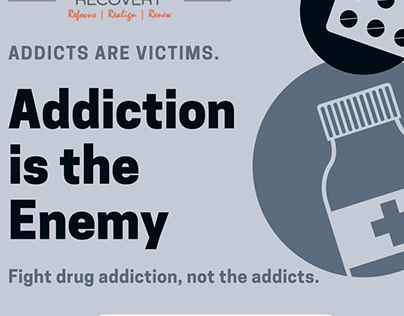Important win in the opioid crisis
Opioid addiction — opioid-use disorder — is a disease, a mental illness, a medical condition that can be treated by medical means. There exist three medications that can treat this condition: two narcotic opioid agonists and one non-narcotic opioid antagonist. An opioid agonist acts on the opioid receptors and causes them to act; an opioid antagonist blocks the opioid receptors and blocks the actions of the receptors.

Credit: behance.net
One opioid agonist is the ubiquitous methadone, and another is the partial agonist buprenorphine. The third medication, a controversial non-narcotic named naltrexone, known by brand names ReVia and Vivitrol, is not rated as highly as the agonist treatments, though patients who have tried it and maintained abstinence while on it, have praised its effectiveness. It can take a while to find a treatment for opioid-use disorder that works for a given individual.
Essential medication needed
The use of buprenorphine in addiction treatment in the U.S. goes back to 2002, when it was first approved for treatment of opioid addiction by the Food and Drug Administration. It is a key medication that is more accessible than methadone, despite the fact that many states have similar requirements, such as monthly counseling and group therapy for getting on and remaining on buprenorphine treatment.
There are inconsistencies in how people can be prescribed buprenorphine. Some clinics require a patient to be actively using opioids, as opposed to actively attempting abstinence; others just require that individuals have a noted medical history of opioid addiction. Some states might have their own requirements.
The requirement for an “X-Waiver” to use buprenorphine was the strictest rule by far. The X-Waiver program, created as part of the Drug Addiction Treatment Act of 2000, essentially only controlled the medication’s prescription, despite being passed before FDA approval was granted. And the scheduling of buprenorphine was changed from Schedule V to Schedule III, so it was then under the aegis of the Controlled Substances Act.
According to its defenders, the FDA’s rescheduling expanded the ability of providers to prescribe the medication and prevented it from being limited to the opioid treatment program model — the same model methadone clinics currently fall under.
End the X-Waiver
While the legal change got buprenorphine out of sole use in the opioid-treatment program, it limited which doctors could prescribe it to those with waivers from the Drug Enforcement Administration – their X-Waiver numbers started with the letter “X.” These waivers limited the number of doctors who could prescribe the medicine; to get an X-Waiver, a doctor would be required to undergo special training in addiction treatment.
It is important to note that this system only applied to doctors prescribing buprenorphine for addiction-treatment purposes. If doctors wanted to prescribe it for pain, they would not need the X-Waiver number. This was an unfair practice because people who have opioid-use disorder need to get this life-saving medication.
Buprenorphine is a key weapon in the battle against the scourge of drug addiction. With an opioid epidemic that is claiming lives every day, everything and anything that can stop the explosion of deaths should be used. The importance of buprenorphine cannot be overstated. It saved the life of this writer and many other people. Unfortunately, the regulation has limited its use and cost lives.
During the outbreak of COVID-19, the opioid epidemic raged in the background of the pandemic lockdown. The protocol of social distancing led to the deterioration of many individuals’ mental health due to isolation; people needed more help than ever for opioid addiction.
The good news was that states and the federal government were altering the requirements for prescribing buprenorphine. Legally, doctors who saw fewer than a set number of patients could prescribe it, as long as they didn’t go over that number. However, to completely abolish the X-Waiver, a new law was required, and the Trump and Biden administrations could not unilaterally end it.
That required a new law, which was passed — the Consolidated Appropriations Act of 2023, the Omnibus Bill, included the Mainstreaming Addiction Treatment Act, which officially ended the X-Waiver program. With that policy abolished and state officials starting to understand the need to reduce the barriers to recovery, people are starting to get the treatment they need. Lives are being saved.
Struggle, not politicians, won
This didn’t come about as a result of politicians’ benevolence. This change took years of struggle by harm reductionists, individuals living with opioid addiction and the loved ones of people who have died of addiction. They fought tooth and nail to have this requirement removed.
Many people whose loved ones perished, because they couldn’t get the medical help they needed, were radicalized to rally against the bureaucracy that controlled buprenorphine prescriptions. Groups like VOCAL-NY and the New York Harm Reduction Educators fought hard to get the X-Waiver abolished and to decriminalize possession of diverted buprenorphine.
The Urban Survivors Union, a drug-user organization, wrote an open letter to President Joe Biden calling for the abolition of the X-Waiver, explaining the dangers and harms caused by its requirement. While the letter was written during the COVID-19 epidemic, its words remained timely and necessary even after the worst of the pandemic has allegedly passed.
The continued fight to abolish the X-Waiver finally succeeded. This is considered a great victory in the fight against opioid addiction. It took years, thousands of deaths and a global pandemic to make this happen. It must be remembered that it is the struggle that made this happen.

